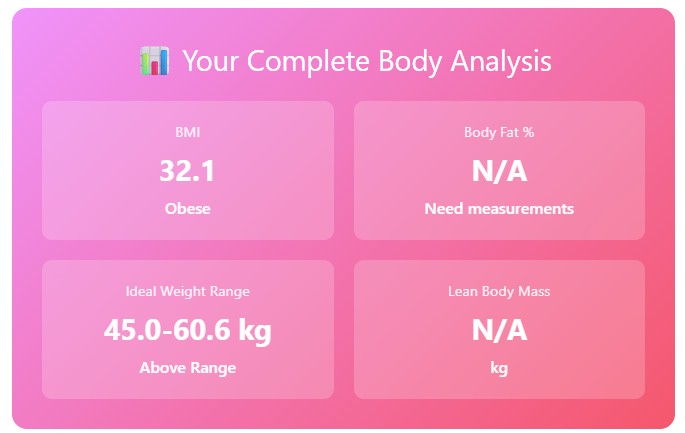🔥 Best Body Measurement Tool Revealed
The #1 Secret Professional Fitness Trainers Use to Transform Bodies – Now Available to You!
🎯 Advanced Features That Make This Tool Stand Out
Instant Results
Get accurate calculations in seconds
Multiple Metrics
BMI, Body Fat, Ideal Weight & More
Easy to Use
Simple interface, powerful results
All Devices
Works perfectly on any screen
💪 Advanced Body Measurement Calculator
📊 Your Complete Body Analysis
📚 Understanding Your Body Measurements
🎯 What is BMI?
Body Mass Index (BMI) is a measure of body fat based on height and weight. It’s a quick screening tool to categorize individuals into weight categories.
- Underweight: BMI below 18.5
- Normal: BMI 18.5-24.9
- Overweight: BMI 25-29.9
- Obese: BMI 30 and above
💪 Body Fat Percentage
Body fat percentage represents the proportion of fat in your body compared to lean mass. It’s a more accurate indicator of fitness than BMI alone.
- Essential Fat: 2-5% (men), 10-13% (women)
- Athletic: 6-13% (men), 14-20% (women)
- Fitness: 14-17% (men), 21-24% (women)
- Average: 18-24% (men), 25-31% (women)
⚖️ Ideal Weight Range
Your ideal weight isn’t a single number but a healthy range based on your height, age, and body frame. This range allows for individual variation while promoting optimal health.
- Considers BMI guidelines
- Accounts for body composition
- Flexible for different body types
- Focus on health, not just numbers
💡 Expert Tips for Body Transformation
Track Progress Regularly
Measure your body metrics every 2-4 weeks. Consistent tracking helps you understand trends and adjust your fitness plan accordingly.
Focus on Body Composition
Don’t obsess over weight alone. Body fat percentage and lean mass are better indicators of true fitness and health progress.
Measure at Consistent Times
Take measurements in the morning before eating for the most accurate and consistent results. Hydration and food intake affect measurements.
Use Proper Measuring Technique
Keep the tape measure parallel to the floor and snug but not tight. Measure at the same spots each time for accurate comparisons.
Set Realistic Goals
Aim for 0.5-1kg weight loss per week if needed. Rapid changes often aren’t sustainable. Focus on long-term healthy habits.
Combine Diet and Exercise
The best results come from balanced nutrition and regular physical activity. Both are essential for sustainable body transformation.
Stay Hydrated
Drink at least 2-3 liters of water daily. Proper hydration affects body composition, metabolism, and measurement accuracy.
Get Quality Sleep
Aim for 7-9 hours nightly. Sleep affects hormones that regulate hunger, metabolism, and muscle recovery. It’s crucial for transformation.


